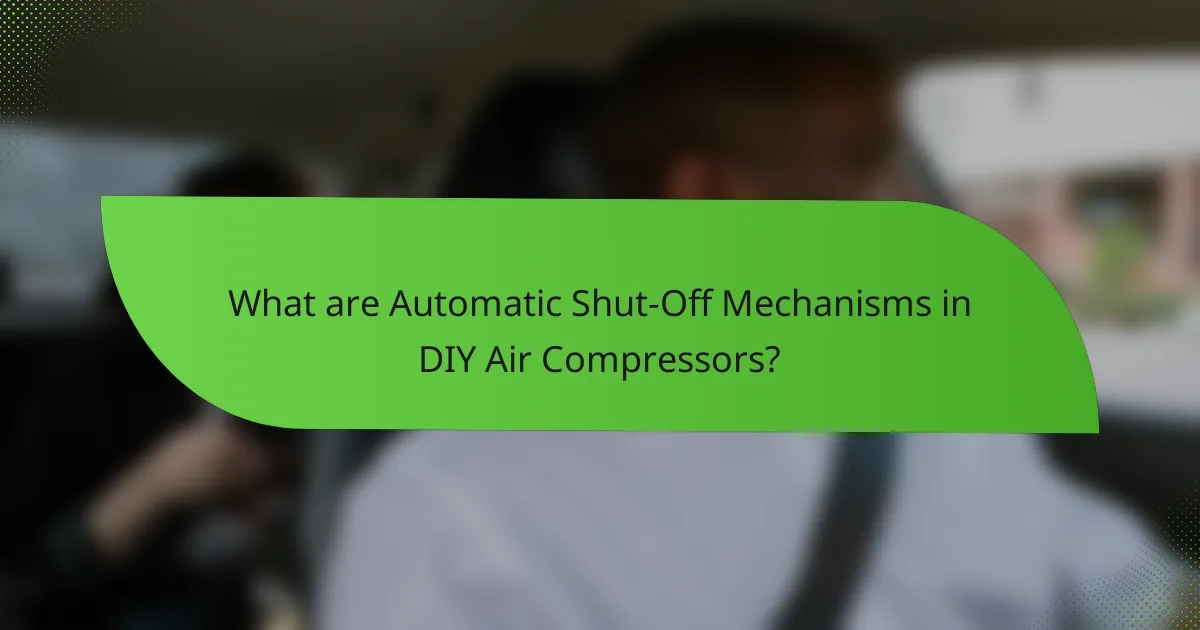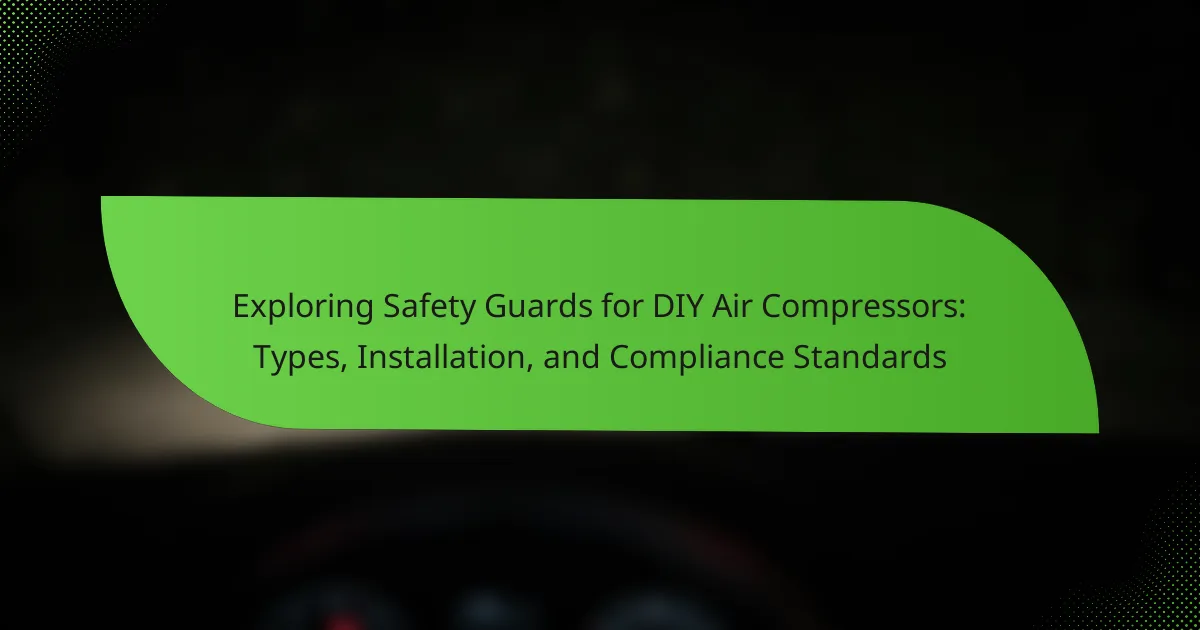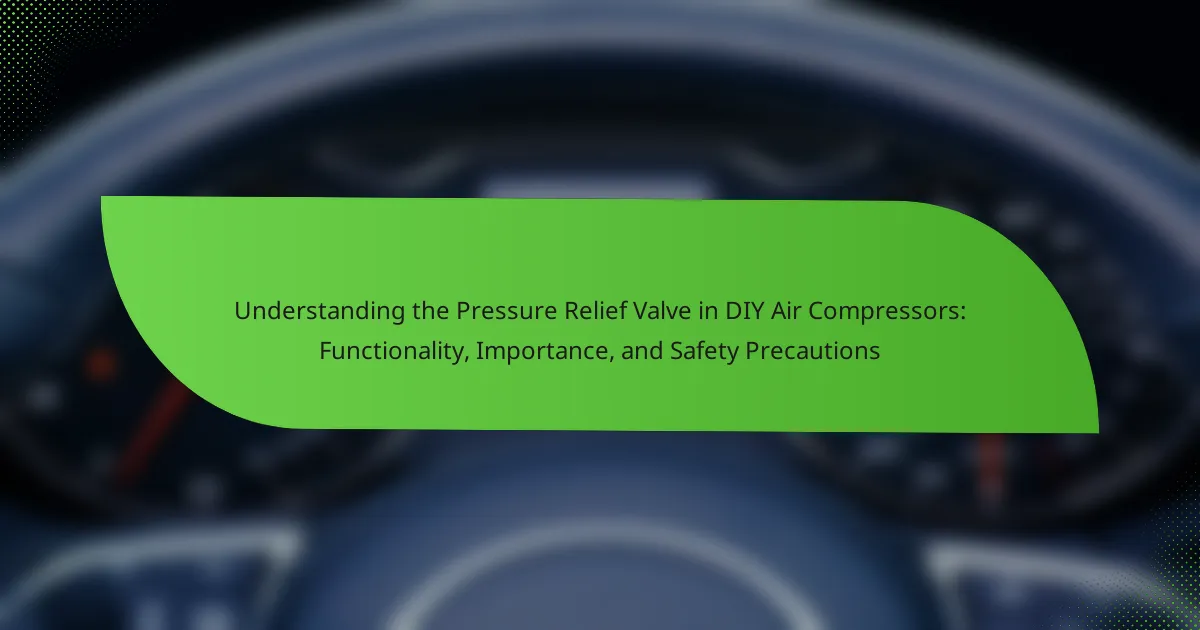Automatic shut-off mechanisms in DIY air compressors serve as essential safety features that deactivate the compressor when a predetermined pressure level is reached. These mechanisms utilize pressure switches to monitor air pressure, preventing over-pressurization that could damage the compressor and connected tools. The article outlines the benefits of these mechanisms, including enhanced safety, improved efficiency, and energy conservation, which can lead to significant cost savings. It also covers best practices for implementing these features, such as selecting the appropriate pressure switch, ensuring proper wiring, and conducting regular tests to confirm functionality. Additionally, the inclusion of a manual override is recommended for emergency situations to maintain user control.

What are Automatic Shut-Off Mechanisms in DIY Air Compressors?
Automatic shut-off mechanisms in DIY air compressors are safety features that stop the compressor when a preset pressure level is reached. These mechanisms prevent over-pressurization, which can damage the compressor and connected tools. They typically use pressure switches to monitor the air pressure inside the tank. When the pressure exceeds the set limit, the switch activates, cutting off power to the motor. This feature enhances safety by reducing the risk of accidents. Additionally, it improves efficiency by ensuring the compressor only operates when needed. Many modern DIY air compressors include this technology for user convenience and safety.
How do Automatic Shut-Off Mechanisms function in air compressors?
Automatic shut-off mechanisms in air compressors function by monitoring pressure levels within the tank. These mechanisms typically utilize pressure switches that detect when the desired pressure is reached. Once the set pressure limit is achieved, the pressure switch sends a signal to the compressor motor to stop operating. This prevents over-pressurization, which can lead to equipment damage or safety hazards.
When the pressure drops below a certain threshold during use, the pressure switch activates the compressor again. This cycle ensures that the air compressor maintains optimal pressure without manual intervention. The reliability of this system is critical for efficient operation and safety in various applications.
What key components are involved in the operation of these mechanisms?
The key components involved in the operation of automatic shut-off mechanisms in DIY air compressors include pressure switches, control circuits, and power relays. Pressure switches monitor the air pressure within the compressor tank. When the pressure reaches a predetermined level, the switch activates. Control circuits manage the signals from the pressure switch. They determine when to turn the compressor on or off based on pressure readings. Power relays act as electrical switches. They control the power supply to the compressor motor. Together, these components ensure safe and efficient operation. The integration of these elements allows for automatic shut-off when the desired pressure is achieved, preventing over-pressurization.
How do these components interact to ensure safety and efficiency?
Automatic shut-off mechanisms in DIY air compressors enhance safety and efficiency by regulating pressure levels. These components work together to prevent over-pressurization, which can lead to equipment failure or accidents. When preset pressure levels are reached, the mechanism activates to stop the compressor. This interaction reduces the risk of explosion or damage to the compressor.
Additionally, the automatic shut-off feature optimizes energy consumption. By stopping the compressor when not needed, it minimizes unnecessary power usage. This contributes to overall operational efficiency. Studies show that equipment with automatic shut-off can extend lifespan by preventing wear and tear from continuous operation. Thus, the interaction of these components ensures both safety and efficiency in air compressor usage.
Why are Automatic Shut-Off Mechanisms important in DIY air compressors?
Automatic shut-off mechanisms are crucial in DIY air compressors for safety and efficiency. They prevent over-pressurization, which can lead to equipment failure or accidents. These mechanisms automatically turn off the compressor when a preset pressure level is reached. This feature protects both the compressor and the user from potential hazards. Additionally, automatic shut-off enhances energy efficiency by reducing unnecessary power consumption. According to the U.S. Department of Energy, energy savings can be significant with proper shut-off features. Thus, these mechanisms are essential for safe operation and optimal performance in DIY air compressors.
What safety benefits do these mechanisms provide to users?
Automatic shut-off mechanisms in DIY air compressors enhance user safety by preventing over-pressurization. These mechanisms automatically stop the compressor when it reaches a predetermined pressure level. This reduces the risk of explosions or equipment failure due to excessive pressure. Additionally, they help prevent overheating by shutting off the compressor when it operates beyond safe temperature limits. This function protects both the user and the equipment from potential hazards. Research indicates that devices with automatic shut-off features significantly lower the incidence of accidents associated with air compressors. For instance, a study from the American Society of Safety Professionals found that such mechanisms can reduce operational risks by up to 70%.
How do they enhance the overall performance of air compressors?
Automatic shut-off mechanisms enhance the overall performance of air compressors by preventing overheating and reducing energy consumption. These mechanisms automatically turn off the compressor when it reaches a set pressure limit. This helps maintain optimal operating conditions, prolonging the lifespan of the unit. Additionally, they minimize the risk of system failure due to excessive pressure buildup. Studies indicate that compressors with automatic shut-off features can operate more efficiently, saving up to 20% on energy costs. Furthermore, these systems contribute to safety by reducing the likelihood of accidents related to over-pressurization. Overall, automatic shut-off mechanisms are essential for improving both efficiency and safety in air compressor operation.

What are the benefits of using Automatic Shut-Off Mechanisms in DIY Air Compressors?
Automatic shut-off mechanisms in DIY air compressors enhance safety and efficiency. They prevent over-pressurization, reducing the risk of equipment damage. This feature also conserves energy by shutting off the motor when the desired pressure is reached. Users benefit from extended compressor lifespan due to minimized wear and tear. Additionally, these mechanisms allow for consistent performance and reliable operation. Studies show that compressors with automatic shut-off can save up to 30% on energy costs. Overall, these benefits make automatic shut-off mechanisms a valuable addition to DIY air compressors.
How do these mechanisms contribute to energy efficiency?
Automatic shut-off mechanisms in DIY air compressors enhance energy efficiency by preventing unnecessary power consumption. These mechanisms automatically turn off the compressor when the desired pressure is reached. This action reduces the running time of the motor, leading to lower energy usage. According to the U.S. Department of Energy, reducing operational hours directly correlates with decreased energy costs. Additionally, these mechanisms help prevent overheating, which can cause energy wastage and damage to the compressor. By maintaining optimal operating conditions, they ensure that the compressor uses energy only when needed. This results in a more efficient overall performance and longer equipment lifespan.
What impact does energy efficiency have on operational costs?
Energy efficiency significantly reduces operational costs. Improved energy efficiency leads to lower energy consumption. This reduction in consumption translates to decreased utility bills. For example, businesses can save up to 30% on energy costs through energy-efficient practices. Additionally, energy-efficient equipment often requires less maintenance. Lower maintenance costs further contribute to overall savings. By investing in energy-efficient technologies, companies can enhance their profitability. Studies show that energy efficiency measures yield a high return on investment over time.
How do users benefit from reduced energy consumption?
Users benefit from reduced energy consumption through lower utility bills. By using less energy, they save money each month. This reduction also decreases the carbon footprint. Lower energy use contributes to environmental sustainability. Additionally, energy-efficient practices can extend the lifespan of devices. For example, appliances that consume less energy often experience less wear and tear. Furthermore, utilizing automatic shut-off mechanisms in air compressors enhances energy efficiency. This ensures that the compressor only runs when necessary, optimizing energy use. Overall, these benefits lead to both economic and environmental advantages for users.
What safety features do Automatic Shut-Off Mechanisms offer?
Automatic shut-off mechanisms provide critical safety features that prevent overheating and equipment damage. They detect abnormal temperature rises and automatically turn off the device. This feature helps avoid fires or explosions due to excessive heat. Additionally, these mechanisms can prevent over-pressurization by shutting off air compressors when pressure exceeds safe levels. This action protects both the compressor and the user from potential hazards. Furthermore, automatic shut-off mechanisms often include alerts or indicators to notify users of the shut-off condition. These safety features enhance overall operational safety and reliability in DIY air compressors.
How do these features prevent potential accidents during operation?
Automatic shut-off mechanisms prevent potential accidents during operation by immediately halting compressor activity when unsafe conditions are detected. These features monitor pressure levels, temperature, and operational time. When parameters exceed safe thresholds, the mechanism activates, cutting power to the compressor. This action reduces the risk of over-pressurization, which can lead to explosions. It also prevents overheating, which can cause fires or equipment damage. Studies show that equipment with automatic shut-off features experience fewer accidents. For instance, a report from the American Society of Safety Engineers highlights a 30% reduction in incidents with such safety systems in place.
What are the implications of these safety features on user confidence?
The implications of safety features, such as automatic shut-off mechanisms, significantly enhance user confidence. These features prevent over-inflation and potential accidents. Users feel more secure knowing that the compressor will stop automatically when needed. This reliability encourages more frequent use of the equipment. A study by the Consumer Product Safety Commission highlights that safety features reduce the likelihood of injuries. As a result, users are more likely to recommend products with these mechanisms. Enhanced user confidence can lead to increased brand loyalty and positive reviews. Overall, safety features play a crucial role in user satisfaction and trust.

What are the best practices for implementing Automatic Shut-Off Mechanisms in DIY Air Compressors?
The best practices for implementing Automatic Shut-Off Mechanisms in DIY air compressors include selecting the appropriate pressure switch, ensuring proper wiring, and testing the mechanism before use. Choose a pressure switch that matches the compressor’s specifications. This ensures accurate pressure readings and reliable shut-off. Proper wiring is crucial for safety and functionality. Use high-quality connectors and follow electrical codes. Regularly test the automatic shut-off feature to confirm it activates at the desired pressure. This testing helps prevent over-pressurization and equipment damage. Additionally, incorporate a manual override for emergencies. This allows users to control the compressor in unforeseen situations. Following these practices enhances safety and efficiency in DIY air compressor operations.
How can users effectively maintain these mechanisms for optimal performance?
Users can effectively maintain automatic shut-off mechanisms in DIY air compressors by regularly inspecting and cleaning the components. Routine maintenance includes checking for dust and debris that may obstruct the mechanism. Users should ensure that electrical connections are secure and free from corrosion. Lubricating moving parts helps to prevent wear and tear. Testing the shut-off function periodically ensures it activates correctly under pressure. Following the manufacturer’s guidelines for maintenance intervals is crucial for optimal performance. Regularly replacing filters can also enhance the mechanism’s efficiency. These practices help prolong the lifespan and reliability of the automatic shut-off system.
What routine checks should be performed to ensure reliability?
Routine checks to ensure reliability of DIY air compressors include inspecting the automatic shut-off mechanism. This mechanism should be tested to confirm it activates at the correct pressure level. Additionally, check the air filter for clogs or damage. A clean air filter prevents performance issues and maintains efficiency. Inspect hoses and connections for leaks or wear. Damaged hoses can lead to pressure loss and safety hazards. Regularly check the oil level in oil-lubricated compressors. Proper lubrication is essential for smooth operation and longevity. Finally, examine electrical components for signs of wear or damage. Faulty wiring can compromise safety and functionality. These checks help maintain reliable performance and safety in DIY air compressors.
How can users troubleshoot common issues with these mechanisms?
Users can troubleshoot common issues with automatic shut-off mechanisms in DIY air compressors by following a systematic approach. First, check the power supply to ensure the compressor is receiving electricity. Inspect the power cord for any visible damage. Next, examine the pressure switch settings. Ensure that the cut-in and cut-out pressures are correctly adjusted. If the compressor does not shut off, test the pressure switch for malfunction. Use a multimeter to verify continuity in the switch. Additionally, inspect the air filter for blockages that could affect performance. A clogged filter can cause the compressor to overwork. Lastly, review the compressor’s manual for specific troubleshooting steps related to the model. These steps are based on common repair practices in the field.
What tips can enhance the user experience with DIY air compressors equipped with these mechanisms?
To enhance the user experience with DIY air compressors equipped with automatic shut-off mechanisms, ensure regular maintenance of the compressor. Clean the air filter frequently to maintain airflow efficiency. Check the oil levels and replace oil as needed for optimal performance. Familiarize yourself with the shut-off settings to prevent over-pressurization. Utilize proper hose connections to avoid leaks and ensure a steady air supply. Always follow the manufacturer’s guidelines for usage and safety. Keep the compressor in a well-ventilated area to prevent overheating. Finally, consider using noise-reducing accessories to minimize operational noise.
How can users maximize the lifespan of their air compressor through proper usage?
Users can maximize the lifespan of their air compressor by following proper usage guidelines. Regularly check and maintain the oil levels if the compressor is oil-lubricated. Change the oil as recommended by the manufacturer to ensure optimal performance. Keep the air filter clean and replace it when necessary to prevent dust and debris from entering the system. Ensure the compressor is used within its rated capacity to avoid overheating and excessive wear. Allow the compressor to cool down after prolonged use to prevent thermal damage. Regularly inspect hoses and fittings for leaks to maintain efficiency. Properly store the compressor in a dry, clean environment to prevent rust and corrosion. Following these practices can extend the operational life of the air compressor significantly.
What resources are available for further learning about Automatic Shut-Off Mechanisms?
Books on automatic shut-off mechanisms include “Automated Continuous Process Control” by J. D. Lee and “Control Systems Engineering” by Norman S. Nise. Online courses on platforms like Coursera and edX cover related topics in automation and control systems. Research papers such as “Design and Implementation of Automatic Shut-Off Mechanism” published in the International Journal of Engineering Research provide detailed insights. Websites like Engineering Toolbox and HowStuffWorks offer practical explanations and applications of these mechanisms. Additionally, industry standards from organizations like IEEE and ASME provide guidelines and best practices.
The main entity of this article is automatic shut-off mechanisms in DIY air compressors. These mechanisms serve as critical safety features that prevent over-pressurization by automatically stopping the compressor when a preset pressure level is reached, thereby enhancing user safety and operational efficiency. The article covers the functionality of these mechanisms, key components involved, their importance in preventing accidents, and the benefits they provide, including energy efficiency and extended equipment lifespan. Additionally, best practices for implementing and maintaining these systems are discussed to ensure optimal performance and reliability in air compressor usage.



